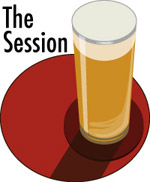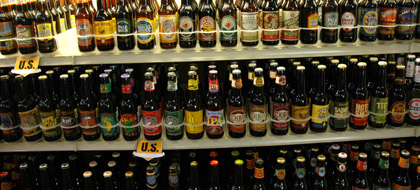 The countdown to April 7 has begun. A good place to follow along is Maureen Ogle’s blog. It will be 75 years ago April 7 that breweries resumed shipping beer, albeit lower strength (3.2% alcohol) until Prohibition was repealed later in 1933. Thus the Brewers Association, Beer Institute and National Beer Wholesalers Association are promoting a 75 Years of Beer celebration.
The countdown to April 7 has begun. A good place to follow along is Maureen Ogle’s blog. It will be 75 years ago April 7 that breweries resumed shipping beer, albeit lower strength (3.2% alcohol) until Prohibition was repealed later in 1933. Thus the Brewers Association, Beer Institute and National Beer Wholesalers Association are promoting a 75 Years of Beer celebration.
So far you won’t see many events listed, but it would be fun to find something like the one Portneuf Valley Brewing plans closer than Idaho. The brewpub will sell a nine-ounce glass of Ligertown Lager for 10 cents, compared with the usual cost of about $2.
Heck, the taxes on a glass of beer run more than 10 cents, which — to be honest — is one of the reasons Prohibition ended. As long as we are celebrating history it’s good to view it from more than one perspective. Beer back = good. Why = more complicated.
If you view American beer history through the filter of Stanley Baron’s “Brewed in America” and then Ogle’s “Ambitious Brew” you’ll see facts hidden in the shadows in one look different in the bright light of the other. Same with “Beer & Food: An American History” and “The U.S. Brewing Industry: Data and Economic Analysis.” (More about all these in Book Reviews.)
Add Amy Mittelman’s “Brewing Battles: A History of American Beer” to the list.
Mittleman has a Ph.D. in history with a special focus on the politics of alcohol production. Obviously that includes examining the role of Prohibitionists, but also taxation — an issue with beer long before the first European settlers arrived in America.
The United States Brewers Association (USBA), the nation’s oldest trade association, was formed in 1862, not coincidentally the same year the federal government started taxing beer. The USBA worked with the government, the government assured that taxes would be collected and the brewers minimizing (as much as they could) how much they would be taxed.
Despite increasing rhetoric from Prohibitionists this was a solid partnership for more than 50 years. Until ratification of the Sixteenth Amendment (introducing federal income tax) in 1913 liquor industry taxes provided more than 50 percent of the federal government’s revenue. Little wonder that if you browse through the USBA’s annual yearbooks from the ‘teens you get a sense that the government surely would not ban the sale of alcohol and eliminate the source of most its income. By 1920 they were wrong about the income and wrong about Prohibition.
Prohibition did not end simply because the federal government, and now the states (which generally had not taxed liquor), reconsidered the need for the taxes liquor generated. However it did take them only a week after beer resumed shipping to pass new taxes. And 75 years later we’re still debating “sin” taxes.
That’s not all there is to this book. It’s certainly academic in tone, with even more footnotes than “Ambitious Brew” (don’t take that wrong; I like footnotes), but Mittleman doesn’t settle for just economics and politics.
Often the details are more interesting than sweeping generalizations, most of which you may already have read. These may be quick facts, such as what brewery workers were paid in the 1860s, or a mixture of culture and politics, like the debate between those who wanted to make the annual release of bock beer a major promotion and those who wanted to discontinue production altogether.
She certainly sees the big picture, for instance using the Miller Brewing arc — beginning with Frederick Miller in the 19th century, rattling the brewing industry in the mid-20th century when Philip Morris buys the company, and continuing in the 21st century as a global company after being acquired by South African Breweries — to take us right up to today.
She does not linger over modern micro/craft brewing, but does get to a point at least one person (me) thinks matters.
The emergence of craft brewing highlights a battle within the brewing industry over authenticity and identity. Since World War II the national brewers have connected beer to all things American — baseball, barbeques, race cars, and pretty, sexy women. Yet the nationalizing of the beer industry removed one of the most potent aspects of beer’s identity — localism. The new generation of brewers emphasizes its connection to place and community even more than taste. They stake a claim to authenticity via their roots in a specific locale.
There’s little chance they’ve been around 75 years, but go ahead and toast them on April 7 (or 5th or 6th, because party dates may vary).

 The Session heads across the Atlantic in April, with
The Session heads across the Atlantic in April, with 